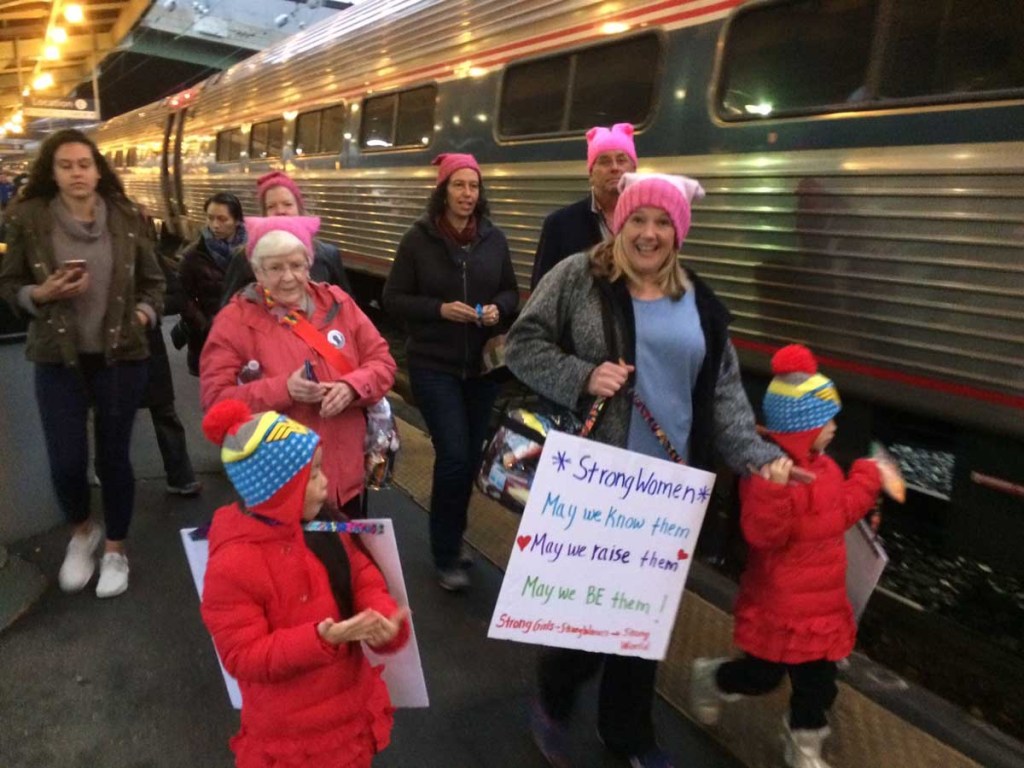Women’s March on Washington: Pink-hatted protesters vow to resist Donald Trump
Published 10:37 am Saturday, January 21, 2017

- A group of people from Massachusetts head into Union Station for the women's march on Saturday.
WASHINGTON – Tens of thousands women, determined to mount a roaring rejoinder to the inaugural gathering for Donald Trump, began descending on Washington Saturday morning for the Women’s March.
Joined by husbands, boyfriends and children and coming from around the country, marchers quickly occupied a growing swath of terrain around the National Museum of the American Indian. March organizers, which originally sought a permit for a gathering of 200,000, said Saturday they now expect as many as a half million participant – potentially dwarfing Friday’s inaugural crowd.
In the hours before the march officially began, participants threatened to choke Metro’s subway lines. Inbound trains were packed with pink-hatted protesters, and the transit agency reported parking lots full at several stations by 8:30 a.m.. A back-up of more than 100 riders struggled to exit through turnstiles at L’Enfant Plaza near the National Mall.
“You won’t get in. We can’t move,” said one woman on the phone from an overrun spot near American Indian Museum. She advised other marchers to seek other spots along the planned route.
After seeing the crowd coming out of the Judiciary Square Metro stop, a woman wearing one of the pink pussy hats being used to symbolize the march turned to a male friend.
“I think they underestimated this thing,” she said.
“They always do,” he replied.
The election of President Trump was the wake up call that progressives needed, Erin Edlow said as she arrived for the march outside the American Indian Museum on the Mall.
Edlow, 28, is the membership director of the Virginia Beach Young Democrats, and she was in town with her sister to demonstrate her support for LGBT and immigrant rights.
“Democracy is not a spectator sport,” she said.
The march is turning into the weekend’s star-studded event, with celebrities including Janelle Monáe, Scarlett Johansson and Ashley Judd making an appearance at the demonstration. Activists Angela Davis and Michael Moore, and D.C. Mayor Muriel E. Bowser, D, also will be speaking.
In the days leading up to the march, the organizers released details about the event, giving marchers and spectators a sense of what the day will look like. The lineup of speakers and performers totals around 50.
“The speakers cut a wide swath across racial justice, reproductive rights, immigrant rights, LGBTQAI, and environmental communities, which reflects the March’s inclusive platform,” the organizers said in a statement.
The largest-ever demonstration in Washington, according to park service figures, was an anti-Vietnam War protest in 1969 that drew 600,000 people.
The Metro transit system warned of long lines at its stations and urged riders to consider alternatives. At the Court House Metro station shortly before 9 a.m., a few hundred people had been waiting for a train for at least 15 minutes when a train came through that was so packed almost no one could board. But people on the platform seemed more encouraged than frustrated. Many smiled and waved at the riders, whom they soon plan to join.
The rally starts at 10 a.m. at the intersection of Independence and Third streets SW.
There will be about three hours of speakers and performances, and at 1:15 p.m. the attendees will begin the march. They will march west until they reach the Ellipse, near the White House.
It is unclear what each of the speakers will talk about, but the speeches are expected to fall under the march’s rallying demand for equal rights for women after Democrat Hillary Clinton, the first female presidential candidate, was defeated in the November election.
The organizers say that the protest is not anti-President Trump, but is instead intended to be a forward-looking, positive demonstration. Still, the organizers recently released a defined, progressively liberal agenda – a sharp contrast to much of what Trump has started to lay out for his presidency.
The platform calls for ending violence against women, workers’ rights, reproductive rights, environmental justice, immigrant rights and more.
“We believe that Women’s Rights are Human Rights and Human Rights are Women’s Rights,” according to the march’s Unity Principles. “We must create a society in which women – including Black women, Native women, poor women, immigrant women, disabled women, Muslim women, lesbian queer and trans women – are free and able to care for and nurture their families, however they are formed, in safe and healthy environments free from structural impediments.”
Planned Parenthood is one of the main sponsors of the event, and the organization’s president, Cecile Richards, is a scheduled speaker. The march’s abortion rights stance has received backlash from antiabortion advocates. They say this excludes their voices from the march, even though they, too, want things such as equal pay and progressive child-care policies.
Linda Sarsour, one of the main organizers of the march and director of the Arab American Association of New York, said the march is for abortion rights but is inclusive to everyone.
Although the march is not an official national event, like the inauguration ceremonies, there will be security. March organizers have secured a permit through the city and have been working with local and federal law enforcement in planning the event. They have also hired a private security firm. Attendees are permitted to bring only small bags and backpacks, and all items are subject to searches.





